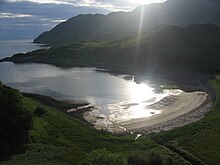Cairn of Kilchoan
The Kilchoan Cairn is located on a low ridge 150 m northwest of Kilchoan Lodge, north of Loch Crinan , at Poltalloch in the west of the Kilmartin Valley in Scotland . The chamber and a small part of the stone mound have been preserved. The rest of the cairn was removed to build the nearby stone walls. So it cannot be stated whether it is a Clyde Tomb .
description
Access to the chamber excavated in 1864 by R. J. Mapleton is to the northeast. It has three compartments divided by panels that are no longer present in the two rear compartments. These compartments are partially covered by capstones. A shifted slab in front of the entrance (2.0 mx 0.75 m and 0.2 m thick) was probably the outer lintel . The side walls of the outer compartment are formed by large double pairs of panels. The slabs, which today also form part of the further side of the chamber, are up to a height of 1.65 m and 1.45 m, respectively, and the lintel originally undoubtedly spanned these two stones. The chamber measures 4.8 m in length. Since Mapleton registered a height of about 2.5 m from the floor to the capstones, the room must currently be filled with rubble to a height of about one meter. The three compartments measure about 1.0, 1.6 and 1.4 m in length from the front to the end stone. The end plate is approximately 0.6 m high. The three (once four) capstones that are still on top measure:
- 2.8 m × 1.6 m and 0.35 m thick;
- 2.1 mx 0.55 m and 0.2 m thick;
- 1.95 mx 1.55 m and up to 0.25 m thick.
It is possible that only the narrow middle capstone in situ remained.
Finds
The list of the material that Mapleton found in the compartments of the chamber is unusually complete for its time. In the outer compartment he found a solid, compact layer of white charcoal that stretched across the entire room. Burnt bones lay on top of this layer, particularly along the sides and in the corners. A flint tool (probably an end scraper) was in the center. In the sandy layer sealed by the solid top layer, he found two elongated flint tools, half of a round carnelian scraper , several unfinished tools and a few chips . Large flat stones were laid in the center, between which burned bones were deposited. The objects found there consisted of a round stone, an unworked leaf-shaped cut, as well as other cuts. In the inner compartment, Mapleton found shards of a vessel and some unburned bones that may represent the remains of a secondary burial. Underneath there was a coarse stone plaster, on top of which was a lot of incompletely burned bones, again primarily on the sides and in the corners, seven flint tools as well as tees. The sand that formed the bottom layer was colored red by fire and contained large pieces of charcoal. The surface appeared to have been exposed to considerable heat. There is evidence that the other departments were similarly fired out.
The stone box
About two meters southwest of the chamber is a northeast-southwest facing stone box . It measures 1.2 m × 0.8 m and is 0.6 m deep. Your floor is about 0.2 m high filled with overburden. The northwest side plate that was still there when Mapleton was excavated is now missing. Two plates lying one behind the other form the northeast end. The oversized but only partially supported capstone measures 2.3 mx 1.4 m and is 0.2 m thick. The stone box only contained a piece or two of charcoal under the sand.
See also
Individual evidence
- ^ RJ Mapleton: Notice of a Cairn at Kilchoan, Argylshire, and its Contents. In: Proceedings of the Society of Antiquaries of Scotland. Vol. 6, 1864/1866, ISSN 0081-1564 , pp. 351-355, ( digital version (PDF; 242.27 kB) ).
literature
- Kilmartin. Prehistoric and Early Historic Monuments. The Royal Commission on the Ancient and Historical Monuments of Scotland (RCAHMS), Edinburgh 2008, ISBN 978-1-902419-03-9 , pp. 20-21, (first published in: The Royal Commission on the Ancient and Historical Monuments of Scotland (RCAHMS): Mid Argyll Cowal. Prehistoric Early Historic Monuments (= Argyll. Vol. 6 = Report. An Inventory of the Ancient and Historical Monuments of Scotland. 24). HMSO, London et al. 1988, ISBN 0-11-493384- 7 ).
Web links
- Entry on Cairn of Kilchoan in Canmore, Historic Environment Scotland database
- Kilchoan of Poltalloch Cairn The Modern Antiquarian (Pictures)
Coordinates: 56 ° 7 ′ N , 5 ° 32 ′ W
